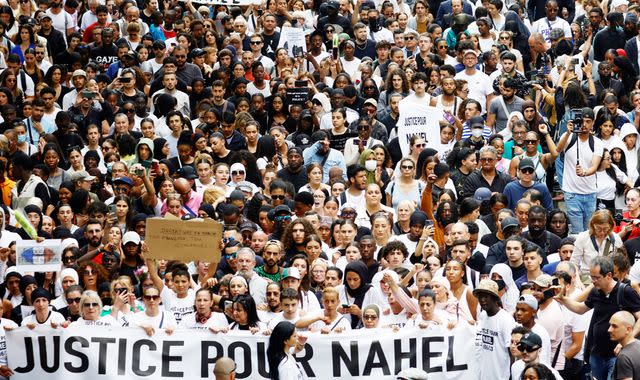Tear gas and stun grenades won't stop riots and protests as long as fear persists in Paris after boy shot by police

Thousands of people crowded onto the streets of Nanterre, many holding banners or placards, demanding "justice for Nahel".
And in the midst of them, sitting confidently on the roof of a vehicle, was the focal point of the demonstration - the woman who has suffered unspeakable pain, and is now channelling her emotion.
Her name is Mounia, and it was her son Nahel - her only child - who was killed on Tuesday morning by a police officer.
You could excuse her for wanting to hide away from the world but instead, she took the lead role here, asking people to join a peaceful protest.
Her son's name was everywhere - on T-shirts, huge banners the width of the road, and chanted as the crowd slowly made its way to the prefecture building.
Nahel was remembered and, for most of the march's length, there was tension and anger but no violence.
Maybe that was because there was also no sign of a police uniform.
Talk to just about anyone here, and they'll tell you a story of how, and why, they dislike, mistrust or simply hate the police.
You hear accusations of brutality, heavy-handed arrests, intimidation and racism.
So while there may have been plain-clothed police officers among the crowd, there was no visible presence at all.
Which, after two nights of rioting, was striking.
Protesters eventually met by tear gas and stun grenades
That changed when the march reached its destination near the prefecture building, effectively the administrative headquarters of the district.
It was a destination that not only represented authority but was also the very place where Nahel's life had come to an end - his car careered to a halt on the far side of the square in front of the prefecture, moments after he had been shot.
And there, protecting the prefecture, were the police.
Lines of vans, full of the CRS riot police who have long been a staple of violent confrontations across France.
And today followed what is now a familiar pattern - rocks and fireworks hurled from protesters; tear gas and stun grenades coming back from the police.
The truth, of course, is that a small minority of people are instigating the trouble and there are plenty across Nanterre and beyond who feel that sense of disenfranchisement from society but don't want to resort to violence.
Read more:
Why does France have such a history of rioting?
Anarchy and anger have gripped the streets
'I am scared of the police'
But it's also true that among them sits a seam of sympathy - people who have seen their streets lit up with fires and conflict, and blame the police.
"I am scared of the police," one man told me. "If they can kill a 17-year-old then they can kill anyone."
There were two other people in the car along with Nahel.
One of them has been detained; the other escaped and was not caught.
But his friends are in touch with him.
One told us that the youngster painted a very different picture of what happened - telling a story of the police screaming at them and hitting Nahel with the butt of a pistol.
He apparently claims that the car moved forward because Nahel's foot slipped off the brake pedal.
We can't substantiate these claims but we do know that the prosecutor has charged the police officer, who hasn't been named, with voluntary homicide.
There is little sign that the promptness of that charge has quelled the anger.
But what those rumours - whether true or not - have done is increase the sense, among some people in some places in this country, that the police didn't tell the whole story; that they remain a problem, rather than a solution.
And as long as enough people believe that, then this disorder may rumble on.

 Yahoo News
Yahoo News 
